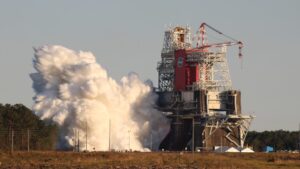That test, the culmination of the Green Run test campaign for the core stage that started in early 2020, is scheduled for Feb. 25 at the Stennis Space Center in Mississippi. Ignition of the stage’s four RS-25 engines is scheduled for around 5 p.m. Eastern, assuming the countdown goes according to plan, officials said during a Feb. 19 call with reporters.
This second Green Run hotfire test is taking place because the first one, Jan. 16, was terminated after 67 seconds, far short of the expected 485 seconds. Program managers later said the early shutdown was triggered when the hydraulic system in one engine hit “intentionally conservative” limits in its flight software. NASA announced Jan. 29 that it would proceed with a second test.
NASA officials initially suggested it could move ahead with launch preparations without a second Green Run test, but concluded that a second hotfire test could be done with minimal risk to the core stage, which will be flown on the Artemis 1 launch.
That decision was welcomed by NASA’s Aerospace Safety Advisory Panel. “We are pleased that NASA decided to proceed with a second attempt at a full-duration burn of the core section in order to obtain the vital data in that last step in the Green Run series of tests,” Patricia Sanders, chair of the panel, said at its Feb. 18 public meeting. “It was really a good decision, a positive decision in order to further risk reduction and eventual success.”
At the Feb. 19 briefing, project officials suggested that the second test need not run the full eight-minute duration to be a success. “The four-minute threshold is something that we’ve looked at for a long time,” said John Honeycutt, SLS program manager at NASA’s Marshall Space Flight Center. “The longer we run, the more data we get.”
Julie Bassler, SLS stages manager at Marshall, said the agency has 10 “detailed verification objectives” for the hotfire test to confirm the vehicle matches the expected performance needed for SLS launches. The earlier test achieved three of those objectives, with partial data for six others and no data for the last objective. “If we go for four minutes, we will collect all the data for those 10.”
Running for longer than four minutes will provide data for secondary test objectives, but are not required to meet the “minimum success criteria” for the test, she said. “One of the reasons you want to go for eight minutes is that it will exactly match what we would do for the launch,” she later noted.
The core stage is ready for the test, despite some complications in recent days caused by winter storms and unseasonably cold weather at Stennis. “The vehicle did not need a lot of refurbishment after the first hotfire. It came out of it in great shape,” said John Shannon, vice president and SLS program manager at Boeing. He estimated that, if the second test went well, the core stage could be refurbished and placed on a barge for shipment to the Kennedy Space Center in about 30 days.
Once at KSC, the core stage will be integrated with its two five-segment solid rocket boosters, upper stage and Orion spacecraft for the Artemis 1 launch. NASA has previously said that launch would take place in November, but even before the first hotfire test in January acknowledged that there was limited margin in that schedule.
Tom Whitmeyer, deputy associate administrator for exploration systems development at NASA Headquarters, said he was still optimistic that Artemis 1 can launch before the end of the year. He noted that a “deterministic” schedule, assuming everything goes well, would allow for a launch as soon as October.
However, he acknowledged later in the call that it’s unlikely everything will go exactly according to plan. “It will take a little bit longer. We’ve got some learning curve to go,” he said, such as with first-time operations and complications from weather and the pandemic. “We will see a date that’s later than that, and it’s really hard to predict exactly what the date will be.”
He still expected that launch to take place this year. “We feel like we’ve got a reasonable chance of launching this year,” he said. “First of all, we really need to get this hotfire behind us. That’s the most important thing we have in front of us.”



